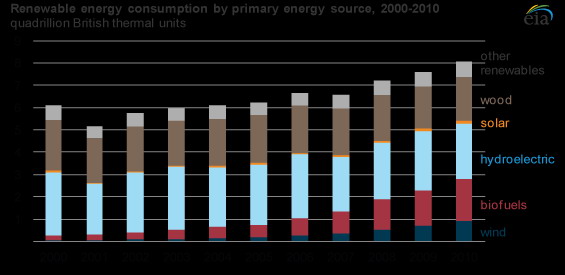博文
美国风能和生物能的利用逐年增加
|||

The production and use of non-hydropower renewable energy sources were up in recent years. Wind and biofuels consumption (the dark blue and red bars) increased about 16 times and 8 times, respectively, between 2000 and 2010. Overall consumption of renewable energy, including hydropower, represented about 8% of total energy consumption in the United States in 2010.
Wind: Electricity generation from wind increased from about 6 billion kilowatthours in 2000 to about 95 billion kilowatthours in 2010. Improved technology has decreased the cost of producing electricity from wind. In addition, several policies contributed to growth in wind power:
- Federal production tax credits and grants provided financial incentives to entities that generate electricity using renewable technologies that are eligible for these programs.
- State-level Renewable Portfolio Standards (RPS) require electricity providers to generate or acquire a certain portion of their power supply from renewable sources. Over half of the states have enforceable renewable portfolio standards and mandated renewable capacity policies. Some states established voluntary goals for renewable generation. Compliance with RPS policies may require or allow for the trading of renewable energy credits (see RECs below).
- Establishment of renewable energy credits (RECs), also known as green certificates, green tags, or tradable renewable certificates, created market mechanisms giving market participants new opportunities to transact for energy generated by renewable sources. RECs can be traded between two parties or through a third party, often a marketer.
Biofuels: Biofuels such as ethanol and biodiesel are transportation fuels derived from biomass materials. Fuel ethanol from corn is the primary biofuel used in the United States. Biofuels are usually blended with petroleum fuels, such as gasoline and diesel fuel, but they can also be used on their own.
In 2010, Americans consumed about 13 billion gallons of fuel ethanol, compared to less than 2 billion gallons in 2000. About 99% of this fuel ethanol was added to gasoline in mixtures up to 10% ethanol and 90% gasoline. Nearly all gasoline sold in the United States contains some ethanol.
Federal and state requirements and incentives encouraging the production and use of biofuels include:
- The Volumetric Ethanol Excise Tax Credit (VEETC) provides blenders with a 45-cent-per-gallon credit for each gallon of ethanol mixed with gasoline for use as a motor fuel.
- The federal "Renewable Fuels Standard" requires that 36 billion gallons of biofuels be used in the United States per year by 2022. Several states have their own renewable fuel standards or requirements.
Biomass—biofuels, wood, and organic waste—is the largest single source of renewable fuel in the United States. However, when the types of biomass are considered as separate categories, hydroelectric power generation is the largest source of renewable energy. Hydroelectric generation increases in some years and decreases in others, primarily due to variation in the amounts of rainfall and snowfall in areas where major hydroelectric dams are located.
https://blog.sciencenet.cn/blog-339326-506417.html
上一篇:夏威夷岛是怎么形成的?
下一篇:[学术讲座]储层地质理论与方法